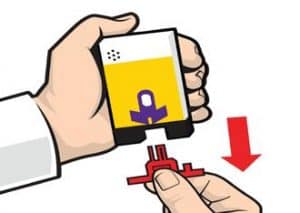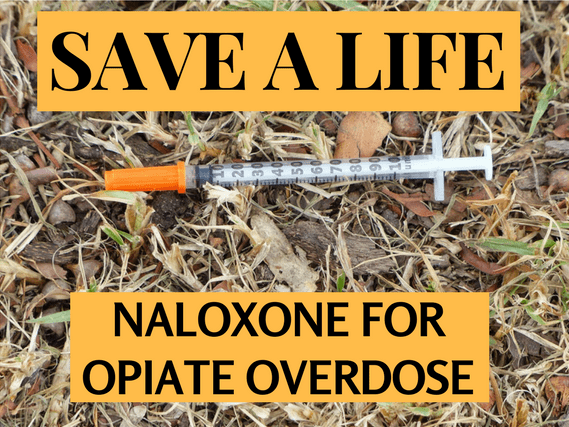We can do more to stop the surge of deaths from opiate overdose. Naloxone is an opiate overdose treatment. It is an antidote that can be used to reverse an opiate overdose (like a heroin overdose). Did you know that over 33,000 people in the United States died from opiate overdoses in 2015? In Connecticut alone there were 723 opiate overdoses in 2015, 444 of them were fatal. According to the CDC, drug overdoses are the leading cause of death of Americans under 50 years old.
Ambulances and hospitals have been treating overdoses with Naloxone for decades. Given the current opiate epidemic, steps have been taken to make Naloxone more accessible to the general public. Naloxone can save the life of a person who is overdosing on an opiate.
 How do I know someone is having an opiate overdose?
How do I know someone is having an opiate overdose?
If a person with a known history of opiate use is showing any combination of the following symptoms seek immediate medical attention by calling 911. The chances of surviving an overdose are significantly increased if Naloxone is immediately provided.
Opiate overdose symptoms:
- Unconscious or minimally responsive with excessive drowsiness or inability to wake the person from sleep. They don’t respond when you shake or pinch them or rub your knuckles hard on their breastbone.
- Slowed or no breathing at all- they might be making loud snoring or gurgling sounds
- Pinpoint or very small pupils
- Slowed heartbeat
- Blue or grey color especially around the fingernails or lips
- Pale and clammy skin
What should you do if someone overdoses?
1. Call 911
If you are unable to arouse the person call 911 – tell them the person isn’t breathing or is having trouble breathing. In Connecticut, you are protected from arrest for drug possession if you act as a Good Samaritan by seeking medical assistance for a person you believe is overdosing. Good Samaritan laws vary by state. Click here to see what the laws are in your state.
Even if you have naloxone with you it is still essential to call 911. Different opiates have various strengths and length of time they last. If a person overdoses on a powerful drug like fentanyl they may end up requiring multiple repeat doses of Naloxone to survive the overdose. It is essential that emergency personnel be immediately notified so they can provide continued care and life-saving treatment.
2. Rescue breathing
If the person isn’t breathing give them rescue breaths. You can help the person get oxygen.
- Put them on their back and open their airway by tilting their head back and lifting their chin.
- Pinch their nose and give 2 breaths first, then one breath every 5 seconds.
- Continue to breathe for the person until they respond to the Naloxone or emergency personnel arrive.
Click on this link for more images and instructions about how to do rescue breathing.
3. Give Naloxone for opiate overdose treatment
Once you have given a few rescue breaths give the Naloxone. Give a second dose of Naloxone if there is no response in 2-3 minutes.
The Maryland Department of Health has a great summary of how to use the different Naloxone products. The following information on naloxone types and directions is from their website.
There are 4 types of naloxone products available
1. For intranasal administration:
2mg/2mL single-dose Luer-Jet prefilled syringe. Includes one luer-lock mucosal atomization device (MAD 300) per dose dispensed.
Directions for use: Spray 1 mL in each nostril. Repeat after 3 minutes if no or minimal response.



2. For intranasal administration: Narcan 4mg dose
Directions for use: Place the tip of the nozzle in either nostril until your fingers touch the bottom of the patient’s nose. Press the plunger firmly to release the dose into the patient’s nose. Remove the device from the nostril and discard. Using a new device, repeat after 3 minutes if no or minimal response



3. For intramuscular injection:
0.4/mL in 1mL single dose vials. Include one 3cc, 23g, 1″syringe per dose dispensed. Include face shield for rescue breathing and alcohol swabs if available.
Directions for use: Inject 1mL in shoulder or thigh. Repeat after 3 minutes if no or minimal response.


4. For intramuscular or subcutaneous injection:
EVZIO® 0.4mg/0.4mL auto-injector, #1 Two-Pack.
Directions for use: Follow audio instructions from the device. Place on the thigh and inject 0.4 mL. Repeat after 3 minutes if no or minimal response.



How does Naloxone work?
Naloxone neutralizes the opioids in the body reversing the symptoms of an opiate overdose. It will help the person regain consciousness and breath again. Naloxone is an antidote to powerful drugs like heroin, methadone, fentanyl, and morphine. Naloxone only works with opiates and will not reverse an overdose from any other substance.
What are the side effects of Naloxone?
Most of the time Naloxone will cause opiate withdrawal symptoms which may be uncomfortable, but they are not life-threatening. These may include headache, changes in blood pressure, rapid heart rate, sweating, nausea, vomiting, diarrhea, stomach pain, and tremors.
Where can I get Naloxone?
Availability of Naloxone to non-medical personnel depends on the state you live in. In some states, you need a physician’s prescription to get Naloxone while in others pharmacists can prescribe it. Visit this link to read more about the laws regarding naloxone in your state. To see your state’s information, click on the map and then click on your state. You will then be able to see what the laws are for obtaining a prescription and the laws regarding immunity from prosecution and liability.
Many states have created maps of pharmacies that can dispense Naloxone. To see if your state has a compiled this data google “naloxone pharmacies in….name of state….”. Once you find this website you will know exactly which pharmacy you can go to get Naloxone.
How much will Naloxone cost?
Many insurance companies will pay for Naloxone. If the Naloxone is not covered look for manufacturer coupons online or go to GoodRx which will give prices and coupons for Naloxone at various local pharmacies.
Each form of Naloxone will cost a different amount. On GoodRx Narcan, which provides two doses of the 4mg intranasal naloxone, is $135. Two vials (one vial per dose) of naloxone to inject are $20 vs 2 doses of Evzio auto-injector are $3,800!! However, Evzio has several patient assistance programs and coupons. If the medicine is ordered through their site without using insurance it is $360. With insurance, they have coupons that will make the copay zero.
Should I get Naloxone?
If you have a loved one that requires prescription opiates or is struggling with opiate addiction I urge you to strongly consider getting Naloxone to carry with you. Unfortunately, the opiate epidemic isn’t disappearing anytime soon and too many people are dying from overdoses.
Naloxone is a safe and effective tool that can save lives. Think of carrying Naloxone like carrying an EpiPen for someone with allergies. Hopefully, you will never need it but it has the potential to save their life in an emergency. Talk to your doctor or pharmacist to find out if obtaining Naloxone is right for you.
For more information about addiction I recommend the following books:
[amazon_link asins=’0544112326,0692631704,1620402521,1626252785,076117611X,0060919698,1501187546,0615942210′ template=’ProductGrid’ store=’drmelissawelb-20′ marketplace=’US’ link_id=’7bae2a2a-cf0f-11e7-b326-213633c68525′]
Don't miss another post!

Subscribe to get our latest content by email.


